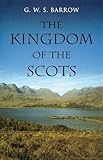The Kingdom of the Scots : Government, church and society from the eleventh to the fourteenth century / G W S Barrow.
Material type: TextPublisher: Edinburgh : Edinburgh University Press, [2022]Copyright date: ©2003Description: 1 online resource (352 p.)Content type:
TextPublisher: Edinburgh : Edinburgh University Press, [2022]Copyright date: ©2003Description: 1 online resource (352 p.)Content type: - 9780748618033
- 9781474464222
- 941.102 23
- DA775
- online - DeGruyter
| Item type | Current library | Call number | URL | Status | Notes | Barcode | |
|---|---|---|---|---|---|---|---|
 eBook
eBook
|
Biblioteca "Angelicum" Pont. Univ. S.Tommaso d'Aquino Nuvola online | online - DeGruyter (Browse shelf(Opens below)) | Online access | Not for loan (Accesso limitato) | Accesso per gli utenti autorizzati / Access for authorized users | (dgr)9781474464222 |
Browsing Biblioteca "Angelicum" Pont. Univ. S.Tommaso d'Aquino shelves, Shelving location: Nuvola online Close shelf browser (Hides shelf browser)

|

|

|

|

|

|

|
||
| online - DeGruyter Language and Computers : A Practical Introduction to the Computer Analysis of Language / | online - DeGruyter The Acts of Malcolm IV (1153-1165) / | online - DeGruyter The Acts of William I (1165-1214) / | online - DeGruyter The Kingdom of the Scots : Government, church and society from the eleventh to the fourteenth century / | online - DeGruyter The 21st-Century Novel : Notes from the Edinburgh World Writers' Conference / | online - DeGruyter Third Way Discourse : European Ideologies in the Twentieth Century / | online - DeGruyter A Glossary of Morphology / |
Frontmatter -- Contents -- Maps -- Acknowledgements -- List of Abbreviations -- Introduction -- PART I GOVERNMENT -- 1 Pre-feudal Scotland: shires and thanes -- 2 The judex -- 3 The justiciar -- 4 The Anglo-Scottish Border -- 5 The Scots and the north of England -- PART II CHURCH -- 6 The royal house and the religious orders -- 7 Benedictines, Tironensians and Cistercians -- 8 The clergy at St Andrews -- 9 King David I and Glasgow -- 10 The clergy in the War of Independence -- PART III SOCIETY -- 11 Rural settlement in central and eastern Scotland -- 12 The beginnings of military feudalism -- 13 Scotland’s ‘Norman’ families -- 14 Growth and structure of the Border -- 15 The earliest Stewarts and their lands -- 16 The highlands in the lifetime of Robert the Bruce -- Index
restricted access online access with authorization star
http://purl.org/coar/access_right/c_16ec
This book explores the formative period when Scotland acquired the characteristics that enabled it to enter fully into the comity of medieval Christendom. These included a monarchy of a recognisably continental type, a feudal organisation of aristocratic landholding and military service, national boundaries, and a body of settled law and custom. By the end of the thirteenth century Scotland had a church based on territorial dioceses and parishes, centres of learning including monastic houses representing the main orders of western Europe, and thriving urban communities whose economic power counterbalanced the aristocracy's. How and to what effect these characteristics were acquired are the main subjects of the book.After the introduction eighteen chapters are divided into three parts devoted to government, church and society. The volume comprises some of the most important as well as the most consistently readable work ever published on medieval Scotland. First published in 1973, it is now reissued in an updated edition. Three additional chapters are included: on the Scots and the north of England in the time of King Stephen, on the Anglo-Scottish border in the middle ages, and on King David I and the church of Glasgow. The book also appears in paperback for the first time.
Mode of access: Internet via World Wide Web.
In English.
Description based on online resource; title from PDF title page (publisher's Web site, viewed 29. Jun 2022)


